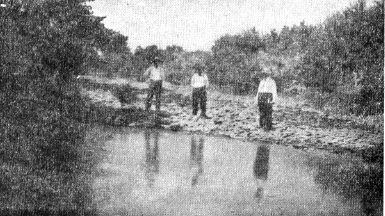Journal of History, Vol. 10 (January 1917):455-461].

CROOKED RIVER BATTLE
GROUND— THE FORD.
The other side or some one in sympathy with them published
the following in the Missouri Argus of November 8, 1838:
Extract of a letter to the Editors, dated Elk Horn, October
30, 1838. On Thursday, the 25th instant, about the dawn of day, a party of
Mormons, about two hundred strong", attached Captain Bogart's company,
consisting of about forty men, on the line dividing" Rav and Caldwell
Counties. On the approach of the Mormons the sentry fired and gave the alarm.
The former advanced within thirty-five paces, formed a line, and received orders
"in the name of Lazarus, the apostles, and Jesus Christ our Lord, to
fire," which was followed by a simultaneous charge, accompanied by demoniac
and hideous yells of "fight for liberty— charge boys— charge— kill
the d——d rascals," etc. Bogart, at the head of his gallant band,
leveled his gun and echoed the command, "Boys, let them have it!" The
struggle was short and desperate. The Mormons were armed with one gun, two long
pistols, a butcher's knife, etc., and rushed to the charge, in which many of our
men came in collision with them and parried their swords, etc., with their guns
and knocked them down. They pursued the charge about six hundred yards. Our loss
was one killed and three wounded— two of the latter were left for dead on the
ground. The loss of the Mormons was nineteen or twenty killed and wounded—
five or 6 of the latter are yet living. They took one prisoner— carried him to
within three miles of Far West, where they had him put to death. The country is
in the highest state of excitement. There are about 2,500 troops within a day's
march of Far West. They are pouring in from all quarters, and we expect in a day
or two, that that town will be laid waste. We are looking for the Governor with
more troops. I have this moment been informed that the Mormons are making every
preparation for a general battle. In the engagement on the 25th they took about
$4,500 worth of horses, etc.
The country was of course excited and agitated, and
conflicting rumors were freely circulated, and many strange versions of the
trouble were sent to the governor, among, others the following: [page 460]
Carrolltown, Missouri, October 24, 1838.
Sirs:
We were informed last night, by an express from Ray County,
that Captain Bogart and all his company, amounting to between fifty and sixty
men, were massacred by the Mormons at Bupcombe, twelve miles north of Richmond,
except three. This statement you may rely on as being true, and last night they
expected Richmond to be laid in ashes this morning. We could distinctly hear
cannon, and we know the Mormons had one in their possession. Richmond is about
twenty-five miles west of this place, on a straight line. We know not the hour
or minute we will be laid in ashes— our country is ruined— for God's sake
give us assistance as quick as possible.
Yours, etc., Sashiel Woods.Joseph Dickson.
Sashiel Woods was a Presbyterian minister who had before
taken an active part in exciting the populace against the "Mormons" in
Carroll and Daviess Counties. Under the circumstances this story was a very
peculiar one. It was written the day before the battle. The cannon referred to
which "the Mormons had in their possession," was a six pounder. The
distance was about fifty miles. To distinctly hear the report of a six pounder
fifty miles, and that the day before it was supposed to be fired, was a
remarkable experience for the reverend gentleman and his fellow reporter. Then
when it is considered that there is no claim on the part of either side to the
conflict that a cannon was used the wonder increases. It was this and similar
reports that inspired the Governor, Lilburn W. Boggs, to issue his famous
exterminating order of October 27, 1838, providing that "The Mormons must
be treated as enemies, and must be exterminated or driven from the State, if
necessary, for the public good."
Among the names of those engaged in this fight on the side of
the Latter Day Saints so far as we have learned were David W. Patten, Parley P.
Pratt, Gideon Carter, Patterson O'Banion, Norman Shearer, Morris Phelps, Darwin
Chase, Luman Gibbs, ———— Hendrix, Amos Hodges, and two sons, James
Durphy, Charles C. Rich, and ————Holbrook.
We have not thought it proper to discuss the merits of
demerits of the acts on either side, but have related as best we could learn the
events historically.
On July 27, 1917, the writer had the privileged of visiting
this historic place in company with Mrs. Smith, Mr. W. E. Dye of Richmond,
Missouri; Mr. and Mrs. L. F. Ferguson of Hardin, Missouri; and Mr. John H.
Thompson who resided near the place. At this time we took the views accompanying
this article.